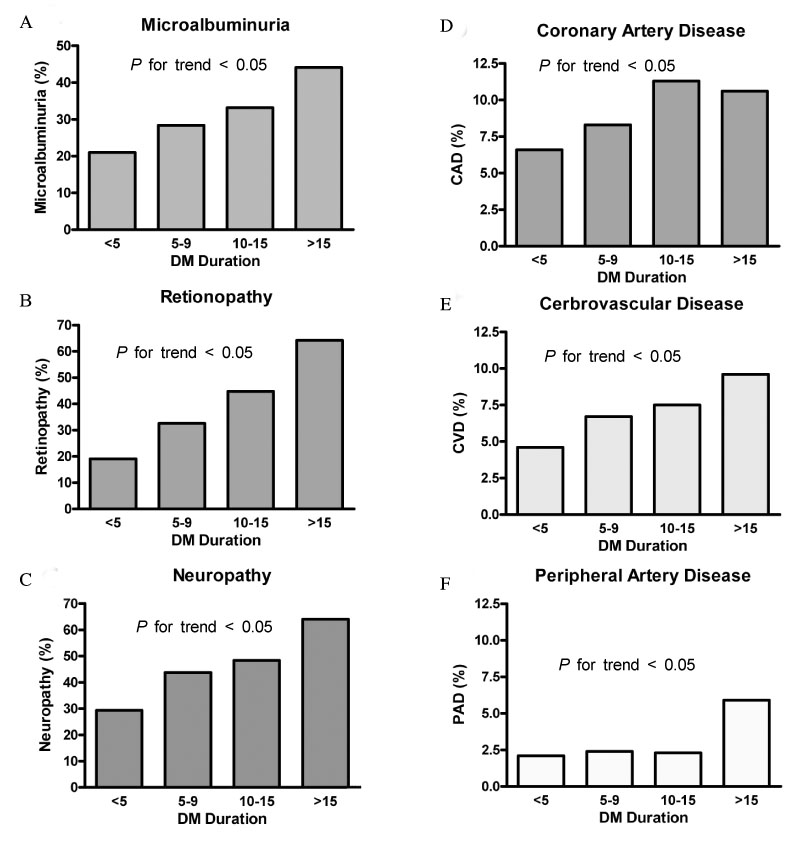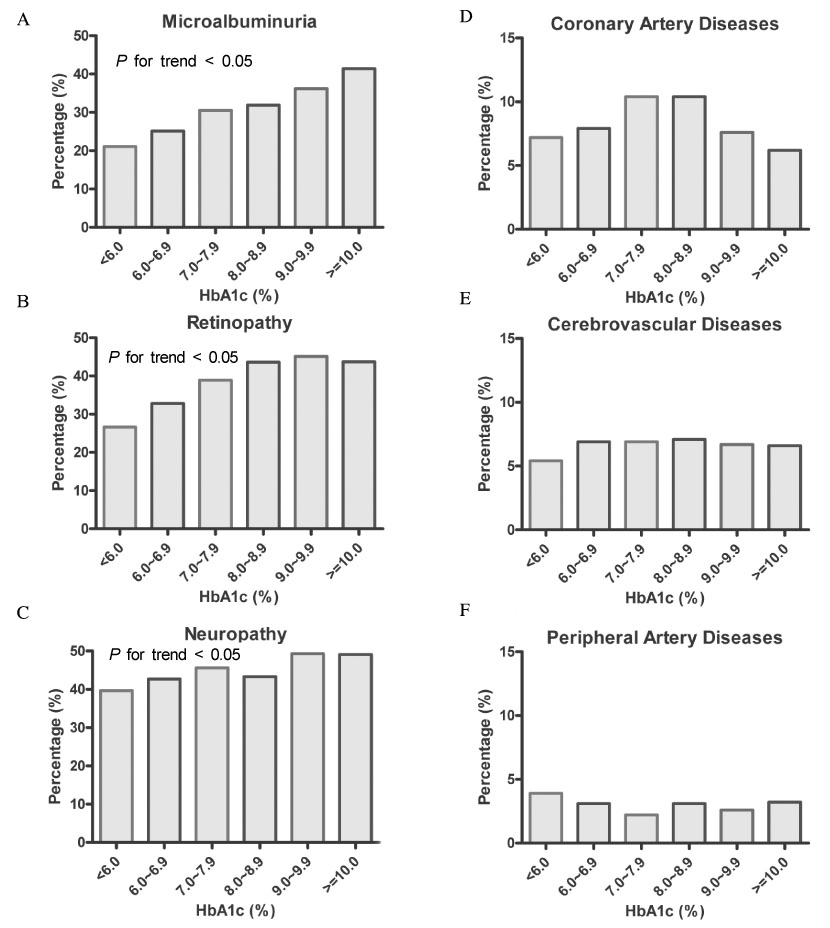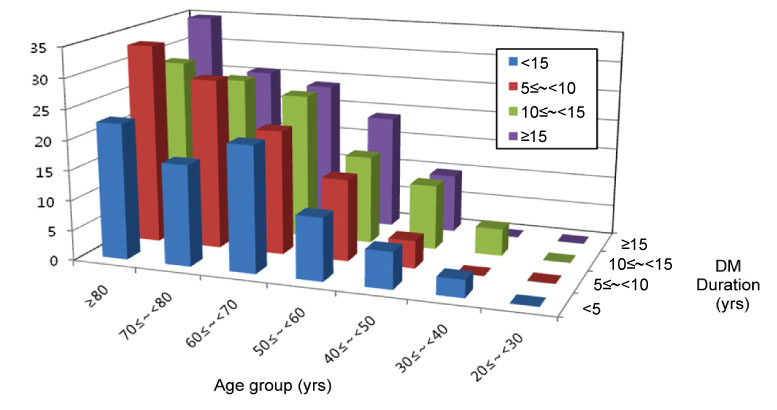Korean Diabetes J.
2009 Feb;33(1):48-57. 10.4093/kdj.2009.33.1.48.
A Nationwide Survey about the Current Status of Glycemic Control and Complications in Diabetic Patients in 2006: The Committee of the Korean Diabetes Association on the Epidemiology of Diabetes Mellitus
- Affiliations
-
- 1Department of Internal Medicine, Seoul National University College of Medicine, Seoul National University Bundang Hospital, Seoul, Korea.
- 2Department of Endocrinology and Metabolism, Ajou University School of Medicine, Suwon, Korea.
- 3Department of Internal Medicine, Kyung Hee University, East-West Neo Medical Center, Seoul, Korea.
- 4Department of Internal Medicine, Uijeognbu St. Mary's Hospital, Catholic University Medical College, Uijeongbu, Korea.
- 5Department of Internal Medicine, Yonsei University Wonju College of Medicine, Wonju, Korea.
- 6Department of Internal Medicine, Cheju National University Hospital, Cheju National University School of Medicine, Jeju, Korea.
- 7Department of Internal Medicine, Yeungnam University College of Medicine, Yeungnam University Hospital, Daegu, Korea.
- 8Department of Internal Medicine, Pusan Paik Hospital, College of Medicine, Inje University, Busan, Korea.
- 9Department of Internal Medicine, Chonbuk National University Hospital, Jeonju, Korea.
- 10Department of Internal Medicine, Chung-Ang University Hospital, College of Medicine, Chung-Ang University, Seoul, Korea.
- 11Department of Internal Medicine, Dongsan Hospital, Keimyung University School of Medicine, Daegu, Korea.
- 12Department of Internal Medicine, St. Vincent's Hospital, Catholic University Medical College, Suwon, Korea.
- 13Department of Internal Medicine, Kyungpook National University Hospital, School of Medicine, Kyungpook National University, Daegu, Korea. leei@knu.ac.kr
- KMID: 2222483
- DOI: http://doi.org/10.4093/kdj.2009.33.1.48
Abstract
-
BACKGROUND: The Committee of the Korean Diabetes Association on the Epidemiology of Diabetes Mellitus performed a nationwide survey about the current status of glycemic control and diabetic complications in 2006.
METHODS
The current study included 5,652 diabetic patients recruited from the rosters of endocrinology clinics of 13 tertiary hospitals in Korea. Age, gender, height, weight, waist circumference and blood pressure were investigated by standard method. Fasting and postprandial 2 hour glucose, glycosylated hemoglobin (HbA1c), lipid profiles, fasting insulin and c-peptide levels were measured. Microvascular (microalbuminuria, retinopathy and neuropathy) and macrovascular (coronary artery disease [CAD], cerebrovascular disease [CVD] and peripheral artery disease [PAD]) complications were reviewed in their medical records.
RESULTS
Mean age of total subjects was 58.7 (+/- 11.6) years and duration of diabetes was 8.8 (0~50) years. Mean fasting and postprandial 2 hour glucose levels were 145.9 +/- 55.0 and 208.0 +/- 84.4 mg/dL, respectively. Their mean HbA1c was 7.9 +/- 1.9%: the percentage of patients within target goal of glycemic control (< 7% of HbA1c) was 36.7%. In this study, 30.3%, 38.3% and 44.6% of patients was found to have microalbuminuria, retinopathy and nephropathy, respectively. Prevalence of CAD, CVD and PAD was 8.7%, 6.7% and 3.0%, respectively. Diabetic complications were closely related with age, duration of diabetes and glycemic control, and this relationship was stronger in microvascular complications than macrovascular ones.
CONCLUSION
Only about one third of patients with diabetes was found to reach target glycemic control in tertiary hospitals of Korea. More tight control is needed to reduce deleterious complications of diabetes in Korea.
MeSH Terms
Figure
Reference
-
1. Harris MI, Flegal KM, Cowie CC, Eberhardt MS, Goldstein DE, Little RR, Wiedmeyer HM, Byrd-Holt DD. Prevalence of diabetes, impaired fasting glucose, and impaired glucose tolerance in U.S. adults. The Third National Health and Nutrition Examination Survey, 1988-1994. Diabetes Care. 1998. 21:518–524.2. King H, Aubert RE, Herman WH. Global burden of diabetes, 1995-2025: Prevalence, numerical estimates, and projections. Diabetes Care. 1998. 21:1414–1431.3. Manson JE, Colditz GA, Stampfer MJ, Willett WC, Krolewski AS, Rosner B, Arky RA, Speizer FE, Hennekens CH. A prospective study of maturity-onset diabetes mellitus and risk of coronary heart disease and stroke in women. Arch Intern Med. 1991. 151:1141–1147.4. Kannel WB, McGee DL. Diabetes and cardiovascular disease. The Framingham study. JAMA. 1979. 241:2035–2038.5. Gu K, Cowie CC, Harris MI. Diabetes and decline in heart disease mortality in US adults. JAMA. 1999. 281:1291–1297.6. Gu K, Cowie CC, Harris MI. Mortality in adults with and without diabetes in a national cohort of the U.S. population, 1971-1993. Diabetes Care. 1998. 21:1138–1145.7. Margolis JR, Kannel WS, Feinleib M, Dawber TR, McNamara PM. Clinical features of unrecognized myocardial infarction--silent and symptomatic. Eighteen year follow-up: the Framingham study. Am J Cardiol. 1973. 32:1–7.8. Goraya TY, Leibson CL, Palumbo PJ, Weston SA, Killian JM, Pfeifer EA, Jacobsen SJ, Frye RL, Roger VL. Coronary atherosclerosis in diabetes mellitus: a population-based autopsy study. J Am Coll Cardiol. 2002. 40:946–953.9. Stamler J, Vaccaro O, Neaton JD, Wentworth D. Diabetes, other risk factors, and 12-yr cardiovascular mortality for men screened in the Multiple Risk Factor Intervention Trial. Diabetes Care. 1993. 16:434–444.10. Nesto RW, Phillips RT, Kett KG, Hill T, Perper E, Young E, Leland OS Jr. Angina and exertional myocardial ischemia in diabetic and nondiabetic patients: assessment by exercise thallium scintigraphy. Ann Intern Med. 1988. 108:170–175.11. Centers for disease control and prevention. Prevalence of self-reported cardiovascular disease among persons aged > or =35 years with diabetes--United States, 1997-2005. MMWR Morb Mortal Wkly Rep. 2007. 56:1129–1132.12. Geiss LS, Herman WH, Goldschmid MG, DeStefano F, Eberhardt MS, Ford ES, German RR, Newman JM, Olson DR, Sepe SJ. Surveillance for diabetes mellitus--United States, 1980-1989. MMWR CDC Surveill Summ. 1993. 42:1–20.13. Liebl A, Mata M, Eschwege E. Evaluation of risk factors for development of complications in Type II diabetes in Europe. Diabetologia. 2002. 45:S23–S28.14. Koro CE, Bowlin SJ, Bourgeois N, Fedder DO. Glycemic control from 1988 to 2000 among U.S. adults diagnosed with type 2 diabetes: a preliminary report. Diabetes Care. 2004. 27:17–20.15. Moon YM, Kim CK, Hahn JS, Lee SY. A clinical study on cardiovascluar complications in diabetes mellitus. J Korean Diabetes Assoc. 1972. 1:39–44.16. Park JH, Kim WH, Kim JH, Park TS, Baek HS. Prevalence of and risk factors for extracranial internal carotid artery stenosis in Korean Type 2 diabetic patients. Diabet Med. 2006. 23:1377–1380.17. Lim S, Koo BK, Cho SW, Kihara S, Funahashi T, Cho YM, Kim SY, Lee HK, Shimomura I, Park KS. Association of adiponectin and resistin with cardiovascular events in Korean patients with type 2 diabetes: the Korean atherosclerosis study (KAS): a 42-month prospective study. Atherosclerosis. 2008. 196:398–404.18. Jung ED, Lee J, Shon HS. The correlation between central obesity and glucose, lipid metabolism and mascrovascular complication in elderly type 2 diabetes. J Korean Diabetes Assoc. 2007. 31:343–350.19. Wetterhall SF, Olson DR, DeStefano F, Stevenson JM, Ford ES, German RR, Will JC, Newman JM, Sepe SJ, Vinicor F. Trends in diabetes and diabetic complications, 1980-1987. Diabetes Care. 1992. 15:960–967.20. Kim SY, Chang YB, Lee HK, Kim YK, Kim EJ. Epidemiological studies on diabetes mellitus in Korea. J Koran Diabetes Assoc. 1979. 5:1–7.21. Nam JH, Lee SH, Lee HJ, Han JH, Jung SW, Koo SM, Kim JG, Kim BW. The prevalence of chronic complications in non insulin dependent diabetic patients. J Korean Diabetes Assoc. 1999. 23:702–714.22. Centers for disease control and prevention. Self-reported heart disease and stroke among adults with and without diabetes--United States, 1999-2001. Morb Mortal Wkly Rep. 2003. 52:1065–1070.23. Charpentier G, Genes N, Vaur L, Amar J, Clerson P, Cambou JP, Gueret P. Control of diabetes and cardiovascular risk factors in patients with type 2 diabetes: a nationwide French survey. Diabetes Metab. 2003. 29:152–158.24. Comaschi M, Coscelli C, Cucinotta D, Malini P, Manzato E, Nicolucci A. Cardiovascular risk factors and metabolic control in type 2 diabetic subjects attending outpatient clinics in Italy: the SFIDA (survey of risk factors in Italian diabetic subjects by AMD) study. Nutr Metab Cardiovasc Dis. 2005. 15:204–211.
- Full Text Links
- Actions
-
Cited
- CITED
-
- Close
- Share
- Similar articles
-
- Glycemic Variability and Diabetes Mellitus
- Detecting and Treating Eating Disorders in Diabetic Patients
- Epidemiologic Characteristics of Diabetes Mellitus in Korea: Current Status of Diabetic Patients Using Korean Health Insurance Database
- Glycemic Control in Diabetic Patients with Diabetic Nephropathy
- Treatment Goals for Glycemia in Older Patients with Diabetes Mellitus





